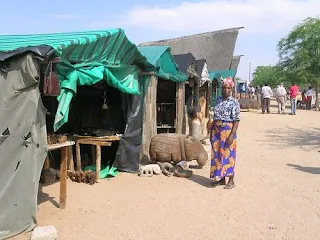March 21, 1990: The Day Namibia Declared Independence
German Colony of Southern Africa
Namibia, situated in the southwestern part of Africa, held a unique historical significance as it represented one of the final bastions of racist colonial rule on the African continent. As the last stronghold of the fascist colonial order, Namibia was among the few remaining territories where colonial powers, in this case, South Africa, still exercised fascist control over the local population and resources.
Before gaining independence on March 21, 1990, Namibia was under South African rule and was officially known as South West Africa. During this period, South West Africa was effectively administered as a province of South Africa. Namibia was officially established as a German colony on August 7, 1884, when German Chancellor Otto von Bismarck claimed the territory on behalf of the German Empire known as German South West Africa.
After World War I, South Africa assumed control of the territory of South West Africa (modern-day Namibia) under a League of Nations mandate. This mandate system was established as part of the Treaty of Versailles and the Covenant of the League of Nations to oversee the administration of former German colonies and territories.
South Africa was granted the mandate to govern South West Africa in 1919. The mandate was intended to be a temporary arrangement, with the administering power expected to govern the territory and promote the well-being and development of its inhabitants until they were deemed ready for self-determination and independence. However, it became a contentious issue as South Africa extended its control and implemented apartheid policies in the territory.
Toward Namibian Independence March 21, 1990.
A key aspect of this historical development is the role of the United Nations (UN). The South West African Political Organization (SWAPO) was established in 1960 and emerged as a vital liberation movement inside and outside Namibia.
In 1966, the UN decided to terminate South Africa's mandate over Namibia and place it under the direct responsibility of the United Nations. SWAPO launched an armed struggle against the South African military and police, who had occupied the territory. It engaged in political and armed struggle to secure self-determination for the Namibian people.
SWAPO's struggle extended beyond the borders of Namibia as it mobilized international support and condemnation of South Africa's actions. A critical turning point occurred in 1978 when the UN adopted Resolution 435/78, calling for the independence of Namibia. This global consensus put immense pressure on South Africa to comply with the UN's decision.
The Apartheid Regime in South Africa in 1960
In 1960, the apartheid regime in South Africa was a system of institutionalized racial segregation and discrimination. Under this regime, the government, primarily controlled by the white minority, implemented a series of laws and policies that enforced the separation of different racial groups, with a focus on maintaining the dominance and privileges of the white population.
Non-white South Africans, particularly the black majority, faced severe oppression, with limited rights, restricted movement, and segregated public facilities. This racial discrimination extended to all aspects of life, including education, healthcare, employment, and housing. The apartheid regime was characterized by systemic racism and inequality, and it was widely condemned internationally for its injustices and human rights abuses.
The Apartheid Regime in South Africa Fights Back
UN Resolution 435/78 was a pivotal decision adopted by the United Nations in 1978. It called for the independence of Namibia, a territory that was under the control of South Africa. This resolution set the framework for the peaceful transition of Namibia to self-governance, marking a significant step towards the end of colonial rule in the region. It established a plan for the withdrawal of South African forces and the holding of free and fair elections in Namibia.
However, the apartheid regime in South Africa employed various tactics to delay the transfer of power. Western powers, including the United States, were complicit in this effort. The USA, in particular, linked the issue of Namibian independence to the withdrawal of Cuban troops from Angola. The Cubans were invited by Angola to defend its sovereignty against South African forces and the rebel organization UNITA.
 |
| Namibia desert |
India took a stand against the Apartheid Regime in South Africa
India took a stand against South Africa's efforts to annex and incorporate South West Africa into its territory. South West Africa, a region located in southwestern Africa, was under South African rule during the era of apartheid.
In 1946, India, along with other nations, opposed South Africa's attempts to extend its control over South West Africa. The United Nations General Assembly rejected South Africa's demand for annexation in December 1946. This rejection was based on the principles of self-determination and decolonization, which aimed to give the people of South West Africa the right to determine their own political future.
India's role in opposing South Africa's annexation of South West Africa was in support of the broader international effort to end colonial rule and promote self-governance in territories that were under the control of colonial powers. This opposition by India and the international community contributed to the eventual independence of South West Africa; Namibia gained independence on March 21, 1990, ending colonial rule and apartheid-era control by South Africa.
The Cold War and Namibia
If it were not for the end of the Cold War, Nambia would not have gained independence. The Cold War was when the United States and the Soviet Union had a long-running rivalry that influenced global politics.
During the Cold War, global politics were heavily influenced by the rivalry between the United States and the Soviet Union, often resulting in support for regimes like apartheid South Africa. This made it challenging for many African nations, including Namibia, to achieve self-determination and independence.
However, with the conclusion of the Cold War, the international environment became more conducive to resolving conflicts and advancing decolonization efforts. The reduced superpower influence and increased support for anti-colonial and anti-apartheid movements created a favorable backdrop for Namibia's independence.
The changing global dynamics after the Cold War were instrumental in helping Namibia break free from colonial rule and apartheid and become an independent nation on March 21, 1990. Namibia means Land of the Vast Desert. The name reflects the country's unique geography and natural landscapes.





